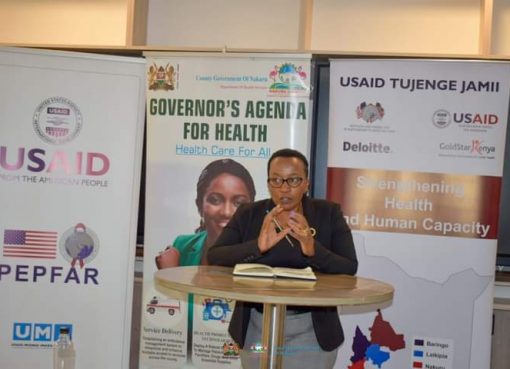Kenya is committed to putting in place an adequate legislative and regulatory framework to provide strict compliance mechanisms for handling and disposal of radioactive waste.
Kenya Nuclear Regulatory Authority (KNRA) interim Chairman Prof. Dickson Andala said the country was also in the process of enacting laws that are supportive of the development of nuclear technologies infrastructure and their long-term sustainability.
Prof. Andala noted that nuclear science technology applications in the country were becoming diverse and many in areas of industrial development, food production, medical diagnosis and treatment of diseases, exploitation of natural resources such as water and exploration and management of mineral resources.
Speaking at Christ the King Hall in Nakuru during a public participation session on nine sets of draft regulations to regulate various usages of nuclear and radioactive usage, the KNRA interim Chairman noted safe use of nuclear technology in power generation, medicine, agriculture and industry would propel Kenya to a new industrialized status, create more jobs and help the country achieve Vision 2030.
Kenya has been gradually undertaking regulatory reforms on nuclear energy and radioactive substances. For instance, in 2019, the country enacted the Nuclear Regulatory Act that set up KNRA.
The law extensively governs nuclear and radioactive usage in Kenya and provides strict compliance measures. The authority has been given a wide mandate to enforce the law.
Similarly, in 2019, the Nuclear Power & Energy Agency (NUPEA) was set up under the Energy Act.
Last year, the KNRA published the draft regulations that also address emergency responses and consumer protection.
Prof. Andala added: “The regulations in general, provide for the prevention, management, safety and responsible usage of radioactive items. The draft regulations mostly protect human beings from harmful effects. Indeed, most of the regulations were proposed by the Cabinet Secretary of Health,”
The authority, according to the interim chairman, was closely monitoring hospitals and industries that had equipment emitting ionizing radiation which were a potential major health hazard for both workers and the general population.
He explained that ionizing radiation consists of particles, X-rays, or gamma rays with sufficient energy to charge the constituent particles of the medium through which it passes and that can affect the chemistry of the body if caution is not observed.
Prof. Andala noted that the alpha, gamma and beta rays, which are produced by radioactive materials, usually industrial wastes or by-products are more damaging.
“Ionizing radiation has more health risks compared to non-ionizing radiation which is emitted by gadgets such as microwaves, refrigerators, personal computers, mobile handsets and telecommunication masts,” stated the interim Chairman.
Prof. Andala urged industries and hospitals dealing with radioactive substances to make use of the Central Radioactive Waste Processing facility and the National Chemical, Biological, Radiological and Nuclear (CBRN) Centre at KNRA’s regional office at Oloolua, Kajiado County.
The facility that was commissioned by President Uhuru Kenyatta on March 18 this year handles the processing of chemical and radiological waste as well as storage of disused radiation sources.
While indicating that Kenya has announced plans to supplement energy sources through nuclear energy according to Vision 2030 and other literature, prof. Andala indicated that the laws would provide very strict compliance checks and enforcement mechanisms for nuclear energy plant operators to ensure that the lives of people, health and environmental safety are not compromised.
Kenya hopes to build a Sh540 billion nuclear power plant in 2027 at a site yet to be confirmed. Some sites that have been proposed include a site along River Tana.
The proposed plant with an initial capacity of 1,000 megawatt (Mw) is expected to be constructed through a concessionaire as the government looks to expand the plant’s capacity fourfold by 2035 under a build, operate and transfer (BOT) model.
According to the World Health Organization, the maximum permissible dose for a radiation worker should be nothing more than 20 millisievert (mSv) per year, with mSv being defined as a high dose of radiation within a short period of time.
Members of the public and those not working in conditions that expose them to radiation can, in any possible circumstance, at most get one mSv per year.
Most people are exposed to radiation in health facilities during X-rays, MRIs, among other technological scanning tests.
“Cancer patients under radiotherapy are affected highly but that is justified because it is only directed at the affected area to kill the cancer cells, while every clinical imaging procedure must be justified,” said Prof Andala.
“The dose cancer patients receive while undergoing treatment is considered to be justified. The benefits they get from radiation treatment by far outweigh the risk,” he said.
Prof. Andala said that there is special equipment (a radiation counter) that is used for measurement of radiation doses.
“Health workers who handle imaging machines like X-rays must be fitted with the radiation counter, which is read monthly to detect the mSv levels,” he added.
Making her contribution, Rukia Ahmed from Youth Bila Noma lobby group expressed concern that most Kenyans were unaware there were various laws in place that protected them from nuclear technology radiation.
Ahmed called for strict vetting and thorough background checks of individuals who will be appointed as enforcement officers once the regulations are adopted.
“Only individuals of integrity should be given the responsibility of enforcing these new rules. If operators or owners of equipment that emit radioactive radiation are not called to account due to compromises made by enforcement officers lives and property of Kenyans will be at stake,” she noted.
Nakuru-East Deputy County Commissioner Eric Wanyonyi said the proposed laws will provide a guideline on how radioactive waste from institutions including hospitals, universities, research institutes, quality inspectors, and manufacturing firms is handled.
Presently, individual institutions store their own waste leading to poor disposal. “Some do not even know what to do with it, exposing innocent and unsuspecting Kenyans to health hazards. These regulations will make institutions more responsible in handling and disposing radioactive waste,” he noted.
In Kenya, radioactive waste is stored at various locations including Nairobi Hospital, Materials Branch of the Ministry of Public Works, the Institute of Primate Research, and the Radiation Protection Board and at the International Livestock Research Institute.
By Anne Mwale and Bernard Kiptoo





